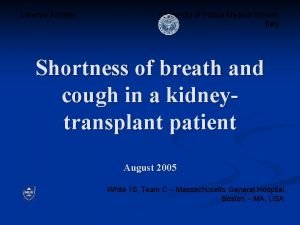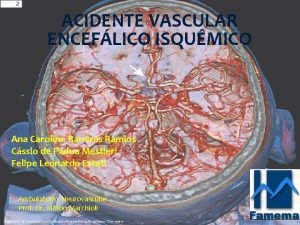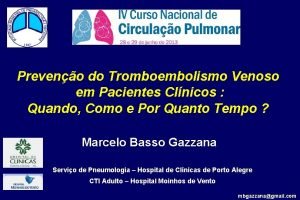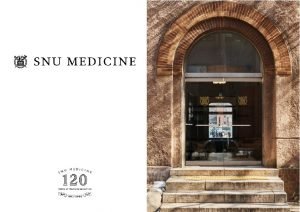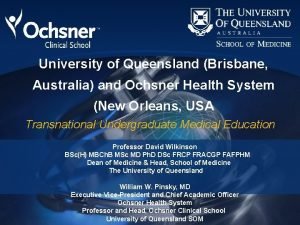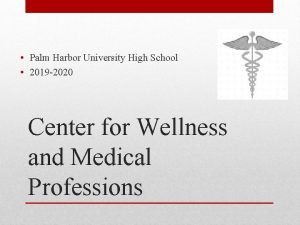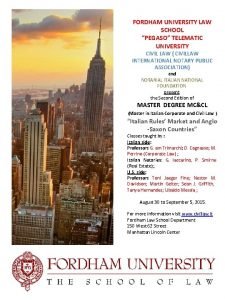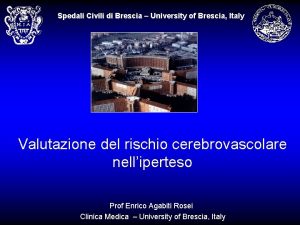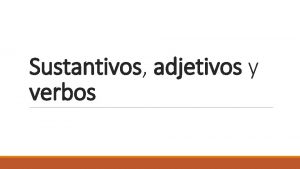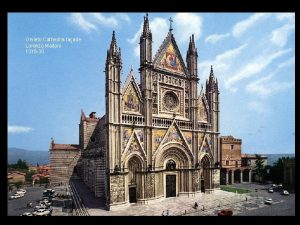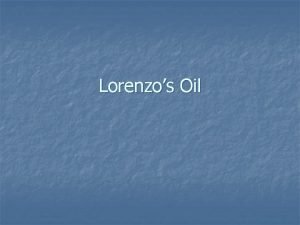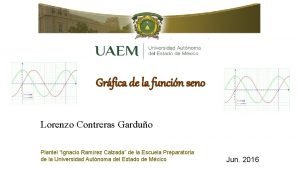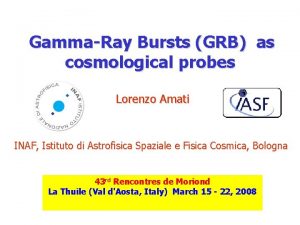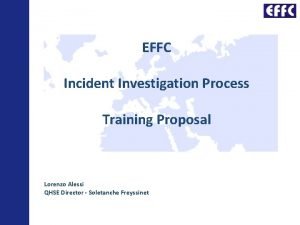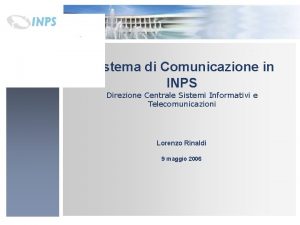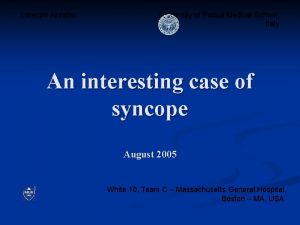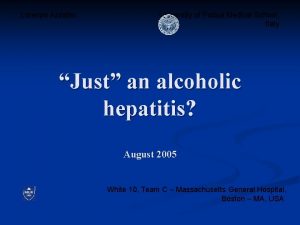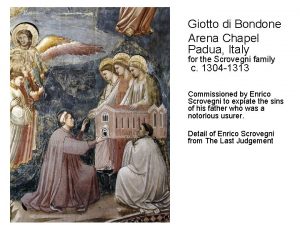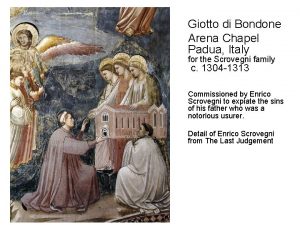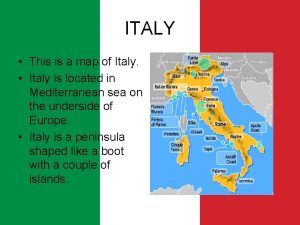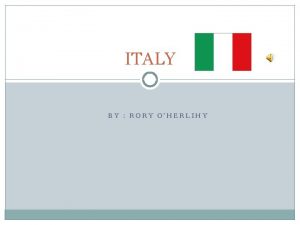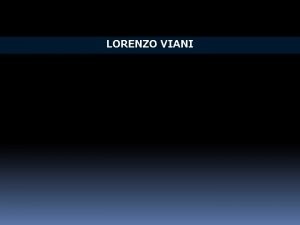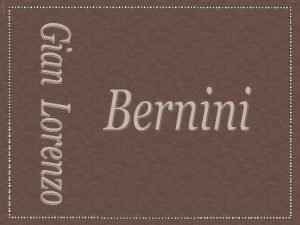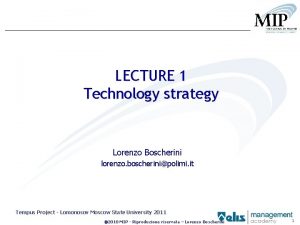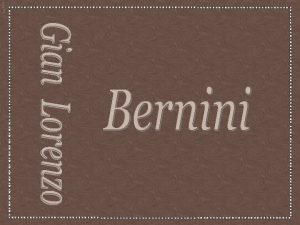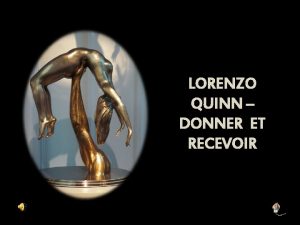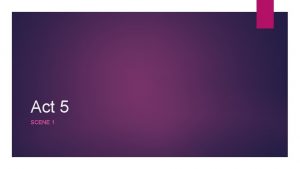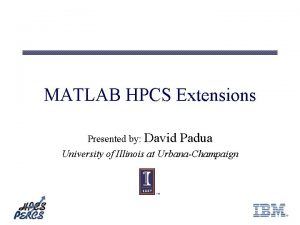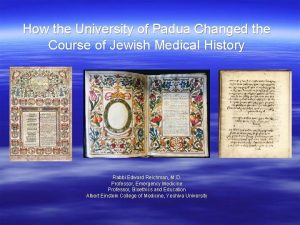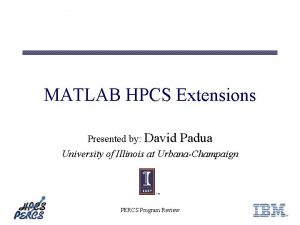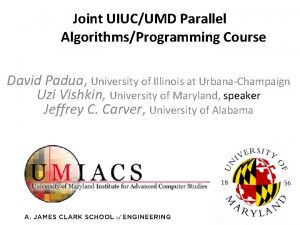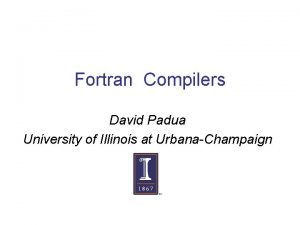Lorenzo Azzalini University of Padua Medical School Italy

































- Slides: 33

Lorenzo Azzalini University of Padua Medical School, Italy Shortness of breath and cough in a kidneytransplant patient August 2005 White 10, Team C – Massachusetts General Hospital, Boston – MA, USA

History of present illness n n n AJMK is a 43 y. o. male with history of ESRD, kidney transplant and asthma Presenting with SOB, cough, headache The pt. was in his usual state of health until 2 weeks prior to admission, when he developed a cough productive of yellow sputum and headache 4 days prior to admission the pt. reports SOB upon 1 flight of stairs (prior to episode, he was able to walk 3 -4 flights of stairs before experiencing SOB) The pt. took Tylenol and Robitussin, without improvement of symptoms He denies fever, nausea or vomiting, but reports chills, chest tightness and wheezing

History of present illness The pt. reports two episodes of pneumonia this year (one in-patient treatment). n He was treated with levofloxacin in the inpatient setting and quickly improved n The pt. also reports that all three of his children recently had hand-foot-mouth disease (evident only in throat), but reports no other sick contacts n

Review of systems n He does report a decrease in appetite, which he believes is secondary to decreased renal function

Past medical history n Membrano-proliferative glomerulonephritis and ESRD – Diagnosed with renal disease in 1995 (for casual finding of proteinuria). Began dialysis in 1997. Right-sided living kidney transplant from his father in 1998, after bilateral nephrectomy. In May 2005, his creatinine increased from a baseline of 3. 5 to 4. 4 mg/dl. He already has a R AV fistula placed (6/’ 05) for secondary access in emergency.

Past medical history CMV infection – May 1998; treated with Ganciclovir IV n Asthma – diagnosed within last year n Hypertension – diagnosed >20 years ago; well controlled, with baseline SBP of 120 mm. Hg n Gastro-Esophageal Reflux Disease (GERD) n Dyslipidemia n

Medications on admission Tacrolimus (Prograf) 2 mg PO Q 12 H n Mycophenolate mofetil (Cell. Cept) 500 mg PO BID n Valganciclovir (Valcyte) 450 mg PO QOD n Esomeprazole (Nexium) 40 mg PO QD n Amlodipine (Norvasc) 10 mg PO QD n Labetalol 400 mg PO BID n Sodium bicarbonate 2600 mg PO twice QOD n Montelukast (Singulair) 10 mg PO QD n

Medications on admission Iron 325 mg PO BID n ASA (Aspirin) 81 mg PO QD n Fluticasone propionate/Salmeterol 500/50 mg (Advair diskus 500/50) 1 puff BID n Nasonex spray n Furosemide (Lasix) 40 mg PO BID n Atorvastatin (Lipitor) 10 mg PO QPM n Multivitamin PO QPM n Renagel (Sevelamer) 800 mg PO TID n

Allergies – NKDA; seafood (itching) n Social history – He lives with his wife and 3 kids (ages 5, 2, 2). He is a merchandiser for a liquor distributor. He denies tobacco, alcohol and illicit drug use. n Familial history – He reports diabetes in great -grandparents. Mother died at 57 from MI. HTN reported in siblings. n

Physical exam Vital signs – T 99. 7, HR 86, BP 140/66, RR 18, Sa. O 2 96% RA n General – the patient appears his stated age and is in non-apparent distress n HEENT – PERRL, sclera anicteric n Neck – no carotid bruits, JVP 8 cm n Nodes – no cervical or supraclavicular LAD n CV – RRR, S 1 & S 2 nl, No m/r/g n

Physical exam Chest – bilateral ronchi in RLL/LLL, no crackles, dullness to percussion RLL n Abdomen - +BS, NT, ND. No HSM. No peritoneal signs n Ext – R AV fistula; 2+ peripheral edema bilaterally on lower extremity to just below the knee n Skin – no rashes n Neuro – A&Ox 3; CN II-XII intact n

Labs and studies Blood Na+ 136 (135 -145) mmol/l K+ 4. 8 (3. 4 -4. 8) mmol/l Cl- 115 (H) (100 -108) mmol/l CO 2 15. 2 (L) (23. 0 -31. 9) mmol/l Ca 2+ 8. 7 (8. 5 -10. 5) mg/dl PO 43 - 4. 8 (H) (2. 6 -4. 5) mg/dl Mg 2+ 1. 4 (1. 4 -2. 0) m. Eq/l

Labs and studies Blood BUN 63 (H) (8 -25) mg/dl Creatinine 6. 1 (H) (0. 6 -1. 5) mg/dl Glucose 105 (70 -110) mg/dl Total proteins 6. 4 (6. 0 -8. 3) g/dl Albumin (3. 3 -5. 0) g/dl Total bilirubin 0. 3 (0 -1. 0) mg/dl Direct bilirubin (0 -0. 4) mg/dl 3. 2 (L) refused

Labs and studies Blood AST 36 (10 -40) U/l ALT 12 (10 -55) U/l ALP 59 (45 -115) U/l Amylase 42 (3 -100) U/l Lypase 3. 0 (1. 3 -6. 0) U/dl

Labs and studies Blood RBC 3. 53 (L) (4. 50 -5. 90) · 109/mm 3 HCT 32. 5 (L) (41. 0 -53. 0) % Hb 9. 8 (L) (13. 5 -17. 5) g/dl MCV 92 (80 -100) fl MCH 27. 7 (26. 0 -34. 0) pg MCHC 30. 1 (L) (31. 0 -37. 0) g/dl RDW 15. 7 (H) (11. 5 -14. 5) %

Labs and studies Blood WBC 9. 0 (4. 5 -11. 0) · 103/mm 3 PLT 223 (150 -350) · 103/mm 3 PT 12. 3 (11. 3 -13. 3) s APTT 27. 9 (22. 1 -35. 1) s

Labs and studies Urine Specific gravity p. H 1. 025 5. 0 (1. 0011. 035) (5. 0 -9. 0) WBC screen Negative Nitrite Negative Albumin 3+ Negative Glucose Trace Negative Ketones Negative kg/l

Labs and studies Urine Occult blood 3+ Sed-RBC 10 -20 (0 -2) /hpf Sed-WBC 0 -2 (0 -2) /hpf Sed-Bacteria Few Negative /hpf Hyaline casts 10 -20 (0 -5) /lpf Squamous cells Negative /hpf Bladder cells Few Negative /hpf Amorphous crystals Moderate Negative

Labs and studies Microbiology CMV antigenemia Negative Blood culture No growth after 5 days Induced sputum Few gram –ve rods of mixed morphologies, few gram +ve cocci in pairs/clusters; no acid fast bacilli; growth of few non-enteric gram –ve rods; no growth of microbacteria after 2 days; no fungi; no P. Carinii

Chest X-Ray

Chest X-Ray n Interval development of right lower lobe pneumonia and small right pleural effusion. Follow-up films to resolution are suggested.

Chest CT

Chest CT n Multifocal air space opacifications and tree-inbud opacities as above may represent inflammatory change, aspiration, or pneumonia. n Bilateral hilar and mediastinal lymphadenopathy, likely reactive in nature.

Assessment and plan n AJMK is a 43 y. o. male with history of ESRD and recurrent lower respiratory tract infections, presenting with SOB, cough productive of yellow sputum and headache. 1) SOB/Cough q SOB/Cough productive of yellow sputum/headache/chills – suggestive of pneumonia. PE ronchi bilaterally. PA & LA CXR: RLL infiltrate and small right pleural effusion. Preliminary sputum gram stain revealed rare gram –ve rods; respiratory and blood cultures pending.

Assessment and plan 1. Asthma – While SOB could be related to asthma, the acute onset along with cough productive of yellow sputum and chills suggests infectious cause. 2. Heart disease – HD could produce SOB and chest tightness; cardiac ultrasound on 7/19/’ 05 showed normal valve structure; trace MR, AI and TI; dilated LA and LV hypertrophy; EF=66%. Diastolic heart failure may play a role in the patient’s shortness of breath and peripheral edema. Diuresis may help with symptoms.

Assessment and plan n Plan n Treatment: Vancomycin 1 g IV for coverage of resistant gram +ve, and Cefepime 2 g IV for gram –ve coverage, in immunosuppressed patient with multiple recent pneumonias n Await final sputum gram stain, respiratory and blood cultures n Chest CT ordered to evaluate pleural effusion and consolidation

Assessment and plan 2) Membrano-proliferative glomerulonephritis and ESRD q Labs and exam consistent with MPGN: UAoccult blood 3+, UA-Sed-RBC 10 -20, UAHyaline casts 10 -20, UA-Albumin 3+ (nephrotic characteristic seen in MPGN); peripheral edema, HTN q Na+ nl, K+ nl, Phos 4. 8 mg/dl q Plasma CO 2 15. 2 mm. Hg – levels have been chronically low, suggesting the kidney’s inhability to make HCO 3 - and handle acid load

Assessment and plan q Transplant 1998; Immunosuppression: Tacrolimus (Prograf) 2 mg PO Q 12 H; Mycophenolate mofetil (Cell. Cept) 500 mg PO BID q Suspect transplant rejection kidney function: Cre 6. 1 (from 4. 1 on 5/27/’ 05); BUN 63 (from 62 on 5/27/’ 05). Continue to monitor Cre and BUN.

Assessment and plan n Plan n Monitor electrolytes n Diet: low K+ and low Phos n Renagel (Sevelamer) 800 mg PO TID n Immunosuppression: Tacrolimus (Prograf) 2 mg PO Q 12 H; Mycophenolate mofetil (Cell. Cept) 500 mg PO BID n Consult renal team and discuss indication to start dialysis (not urgent)

Assessment and plan 3) Volume overload q The patient is thought to be volume-overloaded due to JVP 8 cm, renal disease, BP 140/66 and peripheral edema. n Plan n Furosemide (Lasix) 40 mg PO BID

Assessment and plan 4) Anemia q HCT 32. 5 (from 25. 4 -29 on 5/'05 -6/’ 05), possibly secondary to decreased erythropoietin production by kidney. No plan to transfuse at this time as patient is hemodynamically stable n Plan n Pt. on Epogen 20, 000 units 2/week at home

Assessment and plan 5) CMV q The patient had a CMV infection in May 1998, which was treated with Ganciclovir IV. n Plan n Send CMV antigenemia assay to assess activity of CMV Valganciclovir (Valcyte) 450 mg PO QOD Involve Transplant ID, as specific management questions arise regarding CMV and management of pneumonia

Conclusions Await final sputum gram stain, respiratory and blood cultures to guide treatment of pneumonia n Consult Transplant ID team to n Evaluate the possibility of resuming dialysis n Discuss about CMV- and pneumonia-related issues n
 Lorenzo azzalini
Lorenzo azzalini Petruchio romeo and juliet
Petruchio romeo and juliet Miracle of the repentant son
Miracle of the repentant son Cassio de padua mestieri
Cassio de padua mestieri Escore padua
Escore padua Netclassroom padua franciscan
Netclassroom padua franciscan Seoul national university medical school
Seoul national university medical school Uq som
Uq som Palm harbor university high school medical program
Palm harbor university high school medical program University of salerno province
University of salerno province Pegaso telematic university
Pegaso telematic university Brescia university italy
Brescia university italy Italy school system
Italy school system California medical license for foreign medical graduates
California medical license for foreign medical graduates Gbmc medical records
Gbmc medical records Difference between medical report and medical certificate
Difference between medical report and medical certificate Torrance memorial tcu
Torrance memorial tcu Cartersville medical center medical records
Cartersville medical center medical records Son palabras que nombran referentes puntuales y concretos
Son palabras que nombran referentes puntuales y concretos Lorenzo marmo
Lorenzo marmo San lorenzo and michelangelo's medici tombs
San lorenzo and michelangelo's medici tombs Los indios tacunau marcha de san lorenzo
Los indios tacunau marcha de san lorenzo Lorenzo maitani orvieto cathedral
Lorenzo maitani orvieto cathedral Vlcsfa
Vlcsfa Elementos de las funciones trigonométricas
Elementos de las funciones trigonométricas Lorenzo amati
Lorenzo amati Lorenzo soto rivas
Lorenzo soto rivas Lorenzo alessi
Lorenzo alessi Alberto lorenzo calvo
Alberto lorenzo calvo Gian lorenzo bernini biografía corta
Gian lorenzo bernini biografía corta Rinascimento lodi
Rinascimento lodi David de lorenzo
David de lorenzo Lorenzo marmo
Lorenzo marmo Lorenzo rinaldi inps
Lorenzo rinaldi inps
